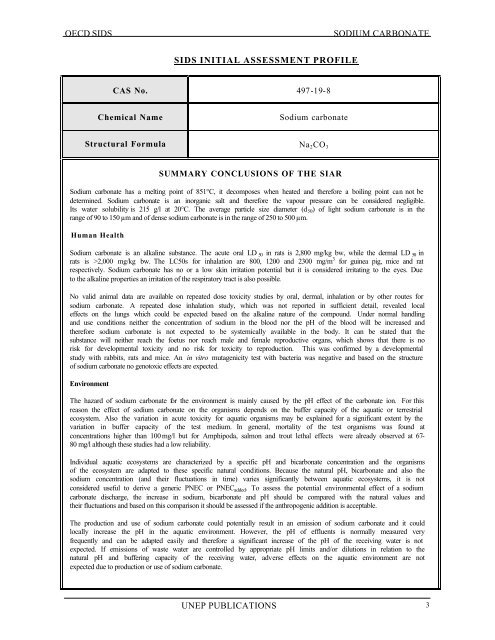SODIUM CARBONATE CAS N°: 497-19-8 - UNEP Chemicals
SODIUM CARBONATE CAS N°: 497-19-8 - UNEP Chemicals
SODIUM CARBONATE CAS N°: 497-19-8 - UNEP Chemicals
You also want an ePaper? Increase the reach of your titles
YUMPU automatically turns print PDFs into web optimized ePapers that Google loves.
OECD SIDS <strong>SODIUM</strong> <strong>CARBONATE</strong><br />
SIDS INITIAL ASSESSMENT PROFILE<br />
<strong>CAS</strong> No. <strong>497</strong>-<strong>19</strong>-8<br />
Chemical Name Sodium carbonate<br />
Structural Formula Na2CO3<br />
SUMMARY CONCLUSIONS OF THE SIAR<br />
Sodium carbonate has a melting point of 851°C, it decomposes when heated and therefore a boiling point can not be<br />
determined. Sodium carbonate is an inorganic salt and therefore the vapour pressure can be considered negligible.<br />
Its water solubility is 215 g/l at 20°C. The average particle size diameter (d50) of light sodium carbonate is in the<br />
range of 90 to 150 µm and of dense sodium carbonate is in the range of 250 to 500 µm.<br />
Human Health<br />
Sodium carbonate is an alkaline substance. The acute oral LD 50 in rats is 2,800 mg/kg bw, while the dermal LD 50 in<br />
rats is >2,000 mg/kg bw. The LC50s for inhalation are 800, 1200 and 2300 mg/m 3 for guinea pig, mice and rat<br />
respectively. Sodium carbonate has no or a low skin irritation potential but it is considered irritating to the eyes. Due<br />
to the alkaline properties an irritation of the respiratory tract is also possible.<br />
No valid animal data are available on repeated dose toxicity studies by oral, dermal, inhalation or by other routes for<br />
sodium carbonate. A repeated dose inhalation study, which was not reported in sufficient detail, revealed local<br />
effects on the lungs which could be expected based on the alkaline nature of the compound. Under normal handling<br />
and use conditions neither the concentration of sodium in the blood nor the pH of the blood will be increased and<br />
therefore sodium carbonate is not expected to be systemically available in the body. It can be stated that the<br />
substance will neither reach the foetus nor reach male and female reproductive organs, which shows that there is no<br />
risk for developmental toxicity and no risk for toxicity to reproduction. This was confirmed by a developmental<br />
study with rabbits, rats and mice. An in vitro mutagenicity test with bacteria was negative and based on the structure<br />
of sodium carbonate no genotoxic effects are expected.<br />
Environment<br />
The hazard of sodium carbonate for the environment is mainly caused by the pH effect of the carbonate ion. For this<br />
reason the effect of sodium carbonate on the organisms depends on the buffer capacity of the aquatic or terrestrial<br />
ecosystem. Also the variation in acute toxicity for aquatic organisms may be explained for a significant extent by the<br />
variation in buffer capacity of the test medium. In general, mortality of the test organisms was found at<br />
concentrations higher than 100 mg/l but for Amphipoda, salmon and trout lethal effects were already observed at 67-<br />
80 mg/l although these studies had a low reliability.<br />
Individual aquatic ecosystems are characterized by a specific pH and bicarbonate concentration and the organisms<br />
of the ecosystem are adapted to these specific natural conditions. Because the natural pH, bicarbonate and also the<br />
sodium concentration (and their fluctuations in time) varies significantly between aquatic ecosystems, it is not<br />
considered useful to derive a generic PNEC or PNECadded. To assess the potential environmental effect of a sodium<br />
carbonate discharge, the increase in sodium, bicarbonate and pH should be compared with the natural values and<br />
their fluctuations and based on this comparison it should be assessed if the anthropogenic addition is acceptable.<br />
The production and use of sodium carbonate could potentially result in an emission of sodium carbonate and it could<br />
locally increase the pH in the aquatic environment. However, the pH of effluents is normally measured very<br />
frequently and can be adapted easily and therefore a significant increase of the pH of the receiving water is not<br />
expected. If emissions of waste water are controlled by appropriate pH limits and/or dilutions in relation to the<br />
natural pH and buffering capacity of the receiving water, adverse effects on the aquatic environment are not<br />
expected due to production or use of sodium carbonate.<br />
<strong>UNEP</strong> PUBLICATIONS 3
















